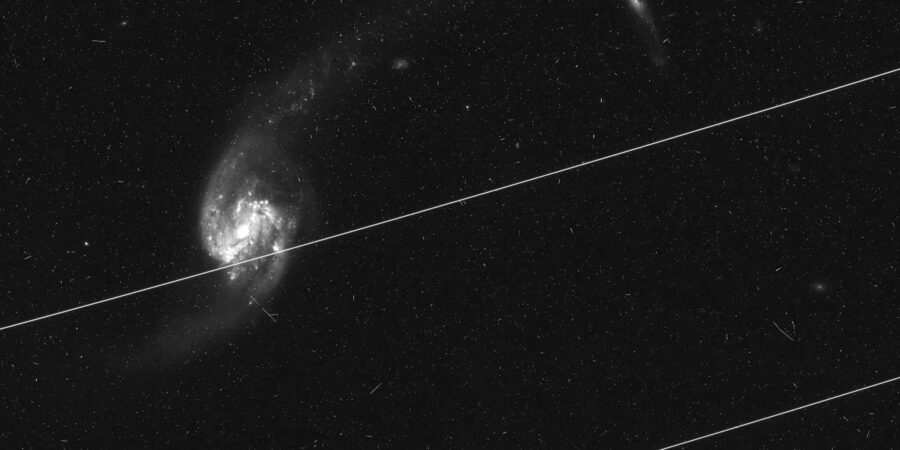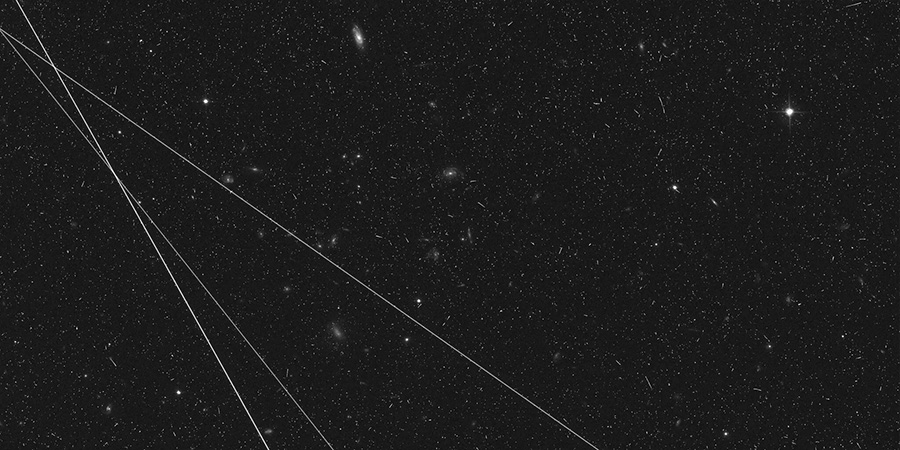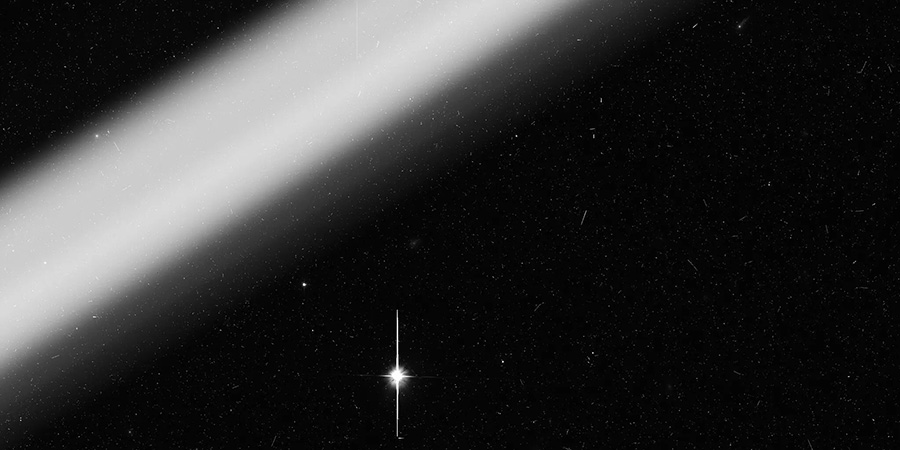An accounting of satellite streaks across two decades of Hubble Space Telescopes finds their appearance is increasing.

NASA / ESA / Kruk et al. / Nature 2023
When SpaceX first began launching its Starlink constellation in 2019, and astronomers began to realize just how bright the satellites would be, CEO Elon Musk glibly tweeted that telescopes would simply have to go to space. Only it turns out that, depending on their orbits, space observatories aren’t safe from light pollution either.
A new accounting of satellite trails in Hubble Space Telescope images, published March 2nd in Nature, shows that the fraction of images affected has doubled over the past two decades. As of 2021, the chance of seeing the streak of a passing satellite in a Hubble image stood at 6%.
The team, led by Sandor Kruk (Max-Planck Institute for Extraterrestrial Physics, Germany), used a novel method to account for satellite trails. The researchers started with comments on an online forum run by the Hubble Asteroid Hunter citizen-science project. Volunteers were perusing images for asteroid trails, which usually appear in images as short curved trails due to Hubble’s motion around Earth. In the process, they would note other image anomalies, such as the straight streaks of satellites. Kruk and colleagues then used this assortment of satellite trails to train two machine-learning algorithms, which picked out straight streaks across observations taken between 2002 and 2021.
The vast majority of these observations were taken before the launch of satellite constellations such as Starlink. The study thus serves as a baseline for comparison against future studies. Even in this timeframe, though, Kruk’s team found a marked increase in satellite trails (50%) that roughly corresponds to the increase in number of satellites (40%).

NASA / ESA / Kruk et al. / Nature 2023
Hubble isn’t alone in its low-Earth orbit, at an altitude of 535 km (330 miles). Other telescopes, such as ESA’s Characterising Exoplanet Satellite (CHEOPS) and NASA’s Near-Earth Object Widefield Infrared Survey Explorer (NEOWISE), also conduct observations from low orbits, and artificial satellites are affecting these space observatories, too. (Observatories farther afield, such as the James Webb Space Telescope that orbits the Sun at 1.5 million km from Earth, remain unaffected.)
“We have now detected close to 3,000 trails in the tiny field of view of CHEOPS, and we do find the fingerprint of Starlink satellites in the dataset,” Nicolas Billot (University of Geneva, Switzerland) tells Sky & Telescope. “We also see a clear increase in the number of such unwanted trails in our data since CHEOPS was launched in December 2019.” A publication with these results is coming soon.
At the time of the analysis conducted by Kruk and colleagues, when there were at most 1,562 Starlink and 320 OneWeb satellites in orbit, the impact on Hubble science was minimal. But now, those numbers have roughly doubled, to 3,703 and 542, respectively, according to statistics collected by Jonathan McDowell (Harvard-Smisthonian Center for Astrophysics). And within a decade, the number of satellites in low-Earth orbit is expected to increase by tens of thousands. Not to mention the likelihood of increased space debris, Billot notes.

NASA / ESA / Kruk et al. / Nature 2023
Kruk’s team estimates that within the decade, satellite streaks will appear in at least a fifth and perhaps up to half of all Hubble images. Satellites at higher orbits will appear more frequently, but leaving narrower trails; satellites at lower orbits, such as the Starlink fleet at 550 km, will appear more rarely but when they do, they’ll leave thick streaks.
If astronomers cannot change this future, then they can at least plan for it, including satellite removal as part of the regular image-processing pipeline for Hubble images. However, Kruk and colleagues acknowledge this can be tricky and will not always be possible.
 10
10









Comments
Graham-Wolf
March 2, 2023 at 3:41 pm
Hi Monica. This is not a "recent" issue, as some might think! Several of us "wrinkly oldies" still recall the large number of Kodak 103aO and 103aF plates, spoilt by similar effects in the 1950s and 1960s. I'm referring to the Palomar Deep Sky Survey, using the venerable 1.2m Oschin Schmidt. At times, it seemed that the survey (Mlim 23 in Blue and Red), might never ever get completed! But it finally WAS...... it just took quite a bit longer, to complete. Graham W. Wolf (46 South, Dunedin, N.Z.).
You must be logged in to post a comment.
Sandy82579
March 3, 2023 at 9:46 am
elon musk, destroying the night sky with 1000 starlink satellites at a time.
You must be logged in to post a comment.
Martian-Bachelor
March 3, 2023 at 11:38 pm
Elon Schmuck is more like it.
The only way to handle this problem is to start shooting these things down.
You must be logged in to post a comment.
Jim Tomney
March 6, 2023 at 1:57 pm
While he may be the poster child for some of this there are others who are intent on providing internet access via satellite constellations. He could stop tomorrow and it doesn't solve the problem.
You must be logged in to post a comment.
SNH
March 3, 2023 at 5:29 pm
"When SpaceX first began launching its Starlink constellation in 2019, and astronomers began to realize just how bright the satellites would be, CEO Elon Musk glibly tweeted that telescopes would simply have to go to space. Only it turns out that, depending on their orbits, space observatories aren’t safe from light pollution either."
Wow. I'm ashamed to say that I hadn't realized that the HST could be affected! I guess I never actually sat down and compared the altitude of Starlinks and Co. to that of the HST. Incredible. Incredibly sad.
You must be logged in to post a comment.
Anthony Barreiro
March 3, 2023 at 7:10 pm
Before dawn this morning the sky was clear here in San Francisco, so I was out in the back yard with binoculars, enjoying the brighter Messier objects that will be visible in the summer evening sky. Everywhere I looked, a satellite passed through my field of view in less than a minute. While I was looking at M3 in Canes Venatici, a trail of dozens of Starlink satellites came through, about 10 seconds apart, each one flaring to second or third magnitude when it crossed from twilight to full sunlight. If that's what our sky is going to look like for the rest of my life, I might just give up. If we want to be able to see the rest of the universe beyond low Earth orbit, we will need to limit the number of artificial satellites.
You must be logged in to post a comment.
Jim White
March 11, 2023 at 11:47 am
Agreed Anthony, but in my mind the "we" needed to really address this is international. Even if the US were able to regulate Starlink Satellites, it would not keep another company (or Starlink) from operating from another country. Just as ships registering in Panama to avoid regulations, and corporations register in Delaware to avoid taxes, companies can find locations to avoid interference with their work. Not likely to happen.
You must be logged in to post a comment.
Anthony Barreiro
March 12, 2023 at 9:21 pm
Thanks Jim. I completely agree. Satellite orbits don't respect international borders. The space around our planet belongs to all of humanity. Fortunately there is already an Outer Space Treaty, established in 1958, administered by the United Nations Office of Outer Space Affairs. Every nation with a significant space program is a party to the Outer Space Treaty. This treaty could be updated to regulate satellites to protect the night sky and astronomy.
You must be logged in to post a comment.
John
March 4, 2023 at 11:27 am
6% of HST, 100% of my deep sky images. I yeild! ... going to solar only...
You must be logged in to post a comment.
Michal
March 6, 2023 at 1:10 pm
Even radio-astronomy is being affected: https://arstechnica.com/science/2023/03/radio-interference-from-satellites-is-threatening-astronomy/
You must be logged in to post a comment.
You must be logged in to post a comment.